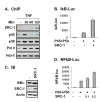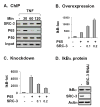Coactivators and corepressors of NF-kappaB in IkappaB alpha gene promoter
- PMID: 15811852
- PMCID: PMC1237005
- DOI: 10.1074/jbc.M500754200
Coactivators and corepressors of NF-kappaB in IkappaB alpha gene promoter
Abstract
In this study, we investigated recruitment of coactivators (SRC-1, SRC-2, and SRC-3) and corepressors (HDAC1, HDAC2, HDAC3, SMRT, and NCoR) to the IkappaB alpha gene promoter after NF-kappaB activation by tumor necrosis factor-alpha. Our data from chromatin immunoprecipitation assay suggest that coactivators and corepressors are simultaneously recruited to the promoter, and their binding to the promoter DNA is oscillated in HEK293 cells. SRC-1, SRC-2, and SRC-3 all enhanced IkappaB alpha transcription. However, the interaction of each coactivator with the promoter exhibited different patterns. After tumor necrosis factor-alpha treatment, SRC-1 signal was increased gradually, but SRC-2 signal was reduced immediately, suggesting replacement of SRC-2 by SRC-1. SRC-3 signal was increased at 30 min, reduced at 60 min, and then increased again at 120 min, suggesting an oscillation of SRC-3. The corepressors were recruited to the promoter together with the coactivators. The binding pattern suggests that the corepressor proteins formed two types of corepressor complexes, SMRT-HDAC1 and NCoR-HDAC3. The two complexes exhibited a switch at 30 and 60 min. The functions of cofactors were confirmed by gene overexpression and RNA interference-mediated gene knockdown. These data suggest that gene transactivation by the transcription factor NF-kappaB is subject to the regulation of a dynamic balance between the coactivators and corepressors. This model may represent a mechanism for integration of extracellular signals into a precise control of gene transcription.
Figures








References
Publication types
MeSH terms
Substances
Grants and funding
LinkOut - more resources
Full Text Sources
Miscellaneous

